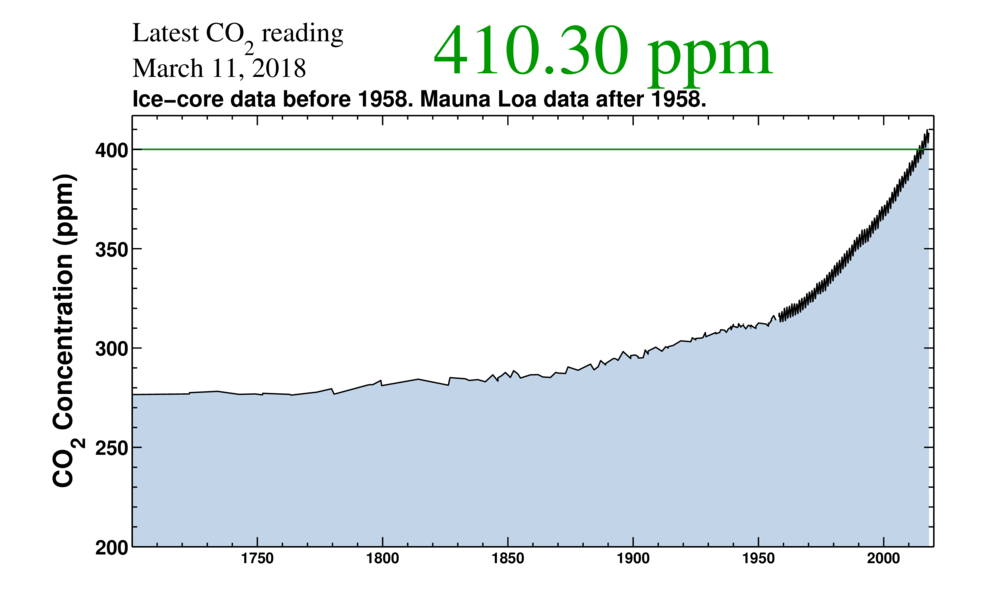
Paris Failing and Arctic Melting
Hope, however, is now fading. The United States, which is currently the largest cumulative (historic) carbon polluter and the second largest absolute (annual total) carbon polluter, withdrew from the Paris Agreement in May 2017. Then, in October 2017, the United States abandoned its Clean Power Plan regulation, which aimed to reduce power plant carbon pollution.
Even more worryingly, global carbon pollution has resumed the pattern of exceeding the previous year’s total. The Global Carbon Project, a consortium of climate scientists, estimates that 2017 reached a new dubious record of 41 billion metric tonnes of carbon dioxide emissions, which exceeded 2016’s emissions by 2%. Concurrently, there is a quickening of extreme weather, drought, wildfires, ocean acidification, Arctic melting, and sea-level rise. To achieve Paris’ objective, carbon pollution must be cut dramatically; plateauing or increasing equate to failure.
The Tragedy of the Commons
The Paris model is encountering the free-rider problem and tragedy of the commons that have long bedeviled climate policy. The shared and limited atmosphere expanse is steadily being overwhelmed by self-interest, depletion, and non-payment of the social costs. If the voluntary pledges, lack of an enforcement mechanism, and U.S. absence are too high a barrier, another approach will be necessary.
One idea, recommended by political scientist David Victor, is the forming of a small group or club of enthusiastic low-carbon committed countries. An integral climate club mechanism would likely be pressure against non-participating countries, such as the imposition of carbon tariffs.
Carbon Tariffs
Carbon tariffs, which are also known as carbon border tax adjustments, are intended to function as carbon equivalent taxes. Consider the following scenario. If a country (or a climate club) intentionally, through government policies such as a domestic carbon tax, rapidly and substantially raises its carbon price to reduce its carbon pollution, it will, at least initially, raise costs for businesses and consumers, especially those with a heavy carbon footprint. Thus, the country’s businesses will be at a competitive disadvantage to businesses in countries that continue as major carbon polluters.
This dichotomy, when recalcitrant countries do not come under comparable carbon pricing regimes, causes carbon leakage to pollution havens. Moreover, if some countries reduce carbon pollution but others do not, overall global carbon pollution will rise or stay the same, and not fall.
To counteract this, the low-carbon country may opt to impose carbon tariffs on imports from the high-carbon country. The objectives are to tax imports with high-carbon content to eliminate their competitive advantage, incentivize the other country to adopt a similar low-carbon regime, and equalize globally the higher carbon price.
Carbon tariffs share a similar objective with antidumping and countervailing duties (AD/CVD): level the playing field. A variation, however, is that AD/CVD aims to protect an individual industry in one country while carbon tariffs aim to protect the planet.
In countries where industry has great influence, carbon tariffs might be a political necessity. To enact carbon tax legislation, carbon tariffs may be required to assuage the concerns or at least weaken the lobbying of carbon-intensive industries. For instance, although the 2010 U.S. carbon pricing legislation failed to become law, its chances were probably improved with the inclusion of carbon tariff like provisions.
Carbon Tariffs and the WTO
Some critics contend that carbon tariffs would run afoul of World Trade Organization (WTO) rules and be a form of eco-protectionism. Others, however, contend that carbon tariffs would be WTO compliant.
Of particular relevance to the legal debate are exceptions in the Global Agreement on Tariffs and Trade (GATT) Article XX, namely measures “necessary to protect human, animal or plant life or health” and “relating to the conservation of exhaustible natural resources if such measures are made effective in conjunction with restrictions on domestic production or consumption.” Subsequently, there would be consideration of several tests in the GATT Article XX Chapeau, namely prohibition of measures that would constitute “arbitrary or unjustifiable discrimination between countries where the same conditions prevail, or a disguised restriction on international trade.”
An Ingrained Conundrum
Climate change mitigation, with its ingrained conundrum, is among the most intractable public policy problems human civilization has faced. The burning of fossil fuels has been the engine of industrialization, economic growth, and poverty alleviation for many. The side-effects, however, now pose grave danger. Special interests and flat-earthers (climate change deniers) are vociferously aligned against transitioning to a low-carbon world. Governments have made promises they are not keeping and many that are open to taking action are unwilling to do so unless others go first. The hour is getting late.
The views expressed in this blog are those of the author and not of any institution he is or was affiliated with.
_____________________________
To make sure you do not miss out on regular updates from the Kluwer Regulating for Globalization Blog, please subscribe here.

